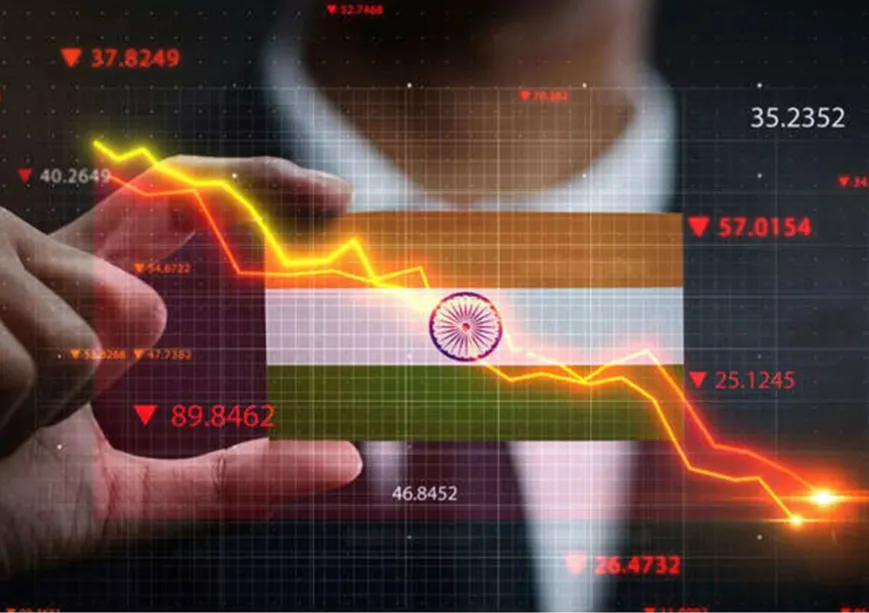-
CENTRES
Progammes & Centres
Location
The Indian economy is at a defining moment where the future might show a reversal from the trend of the consumption-driven growth phenomenon

The National Statistical Office (NSO) of India released three significant estimates by the end of February 2024 – a) the second advance estimates of the current fiscal year, i.e., 2023-24; b) the quarterly estimates of the Gross Domestic Product (GDP) for the third quarter of that same fiscal; and c) the first revised estimates of the previous fiscal year, i.e., 2022-23. The numbers came almost within a week of the release of the Household Consumption Expenditure Survey. The moment is therefore opportune for a coherent discussion on the consumption-driven growth hypothesis for the Indian economy by combining the numbers emerging from the various datasets. While there may be other discussions on the statistical robustness of the estimates by bringing about the concern of consistency across the datasets, the same has been kept in abeyance for the sake of this analysis. In any case, there is one consistent inference that may be drawn from all the estimates – the Indian economy has garnered enough momentum to burst all bubbles of pessimism and silence all the doomsayers whose logic hardly holds water in reality.
Real GDP growth for 2023-24 is estimated at 7.6 percent against the nominal growth rate of 9.1 percent. The second advance estimates, calculated using a higher number of inputs and less extrapolation, is over 4 percent higher than the first advance estimate of 7.3 percent. Further, the year-on-year growth rate of the October-December quarter (Q3) was estimated at 8.4 percent in real terms, and 10.1 percent in nominal terms. This places Q3 as the best-performing quarter, outstripping the growth rates of 8.2 percent and 8.1 percent in Q2 and Q1, respectively.
Table 1: Second Advance Estimate of National Income and Components (in INR crore)
| Item | 2021-22 (2nd RE) | 2022-23 (1st RE) | 2023-24 (SAE) | Percentage Change Over Previous Year | |
| 2022-23 | 2023-24 | ||||
| Gross Domestic Product (GDP) | 1,50,21,846 | 1,60,71,429 | 1,72,90,281 | 7 | 7.6 |
| Share in GDP (%) | |||||
| Private Final Consumption Expenditure (PFCE) | 58.1 | 58 | 55.6 | ||
| Government Final Consumption Expenditure (GFCE) | 9.9 | 10 | 9.6 | ||
| Gross Fixed Capital Formation (GFCF) | 33.4 | 33.3 | 34.1 | ||
| Changes in Stocks (CIS) | 1.1 | 1.1 | 1.1 | ||
| Valuables | 1.9 | 1.4 | 1.5 | ||
| Exports | 22.6 | 23.9 | 22.6 | ||
| Imports | 23.6 | 24.4 | 25.1 | ||
| Discrepancies | -3.3 | -3.4 | 0.7 | ||
| GDP | 100 | 100 | 100 | ||
| Per capita National Product (figures in INR) | |||||
| Per Capita GDP (₹) | 1,09,762 | 1,16,216 | 1,23,945 | 5.9 | 6.7 |
| Per Capita GNI (₹) | 1,08,345 | 1,14,478 | 1,22,110 | 5.7 | 6.7 |
| Per Capita NNI (₹) | 94054 | 99404 | 1,06,134 | 5.7 | 6.8 |
| Per Capita PFCE (₹) | 63807 | 67423 | 68857 | 5.7 | 2.1 |
Source: MoSPI
Just a cursory glance at the second advance estimates, reveals multiple aspects of the Indian growth story. GDP growth is projected at 7.6 percent, while per capita GDP is expected to grow at 6.7 percent – being controlled by the annual population growth rate of around 0.8 percent. However, a distinctive feature from the past trend arises when the growth in per capita consumption expenditure is seen at only 2.1 percent against the 6.7 percent of GDP per capita. This is striking as generally over 55 percent of GDP has so far been contributed by private final consumption expenditure (PFCE), and historical data bears ample testimony of a clear co-movement of GDP growth and private final consumption growth reinforcing the consumption-driven-growth hypothesis for India (Fig. 1).
There is a clear reversal of that trend of consumption being the prime driver of growth if one looks at these latest numbers: The growth in PFCE of around 3.2 percent[1] is much lower than GDP growth. As such, a consumption-led growth is in conformity with the neo-Keynesian postulation, where aggregate demand stimulates output growth, exploiting the underutilised resources. This is antithetical to the classical economics setup or the infamous Reaganomics, which assumes the trickling down of overall economic progress trickles down, ensuring welfare.
A consumption-led growth is in conformity with the neo-Keynesian postulation, where aggregate demand stimulates output growth, exploiting the underutilised resources.
The big question is: Is India moving out of the traditional consumption-driven growth phenomenon? If that is the case, then there must have been other drivers of growth that are emerging. This seems to be in the form of capital expenditures and investments that have increased the gross fixed capital formation lately. Recent estimates suggest that the multiplier effect of capital expenditure is as high as 2.45 implying an INR 1 increase in the same will result in an INR 2.45 increase in the GDP. It needs to be discussed and debated now whether this will be a welcome move if the trend continues in the future. While nations like China devised policies to move towards consumption-driven growth, the phenomenon was largely organic in the Indian context. It has been perceived that the robust growth that India has experienced amidst a global slowdown was primarily because its consumers could hold on to their purchasing power, maintain a high propensity to consume, and have optimistic expectations eliminating the need for excessive savings.
We would rather argue that this departure from the trend is good for the Indian economy in the medium and the long run. From a growth perspective, overreliance on one driver (i.e. consumption) may not be ideal. Moreover, it has also been argued that increasing wealth inequality in India can come in the way of consumption-driven growth. This creates the imperative for diversifying the growth driver in a departure from the past trend. However, that does not mean that consumption-driven growth phenomenon should be done away with. Rather, consumption demand is an all-weather friend for the Indian economy for spurring growth. What entices foreign investors and can spur domestic private investment in India is India’s massive consumption demand potential with a population of 1.43 billion (with around 58 percent being below the age of 30) whose incomes are not only rising at 8.3 percent. There is no other economy that can present such a massive product market with such increasing purchasing power and propensity to consume. Consumer confidence therefore has to play a key role here.
While India boasts of a rising middle class, one needs to keep in mind that the propensity to consume is higher among the middle- and lower-income groups as compared to the rich and the super-rich. This implies that a 1—INR increase in the hands of the middle- and lower-income constituents is likely to get into the consumption stream, while the same increase in the hands of the rich and the super-rich is like to be channelised into the savings stream leading to asset creation and great wealth inequality. Therefore, to stimulate the consumption stream, the disposable incomes of the middle and lower-income groups also need to increase. There are multiple avenues for that – increased government spending targeted at raising the average income of low-income households, allowing investment opportunities that reduce the leakages involved with conservative savings channels, and focusing on inclusive growth.
Greater focus on services, as well as services entangled in the manufacturing value chains is imperative to bolster growth by riding the Fifth Industrial Revolution (5IR) wave – this can ensure multi-level cooperation between technology and people, delivering truly holistic progress.
Inclusive growth demands sustainable livelihoods. This should be approached through the nurturing of industries that hold the potential for economic growth, in tandem with sustainable employment. According to the second advance estimate, the majority of the economic activity takes place in the service sector. Moreover, the service sector yields a double dividend – economic growth augmented with quality employment. Greater focus on services, as well as services entangled in the manufacturing value chains is imperative to bolster growth by riding the Fifth Industrial Revolution (5IR) wave – this can ensure multi-level cooperation between technology and people, delivering truly holistic progress. It is also here that the need for carefully designed prudential policies emerges to factor in Indian diversity and capacity. Further, private investment can be mobilised through increased capital expenditure by the government, which will facilitate industries to emerge, that have a higher rate of return.
The Indian economy is at a defining moment where the future might show a reversal from the trend of the consumption-driven growth phenomenon. While this diversification needs to be welcomed, the welfare implication of the consumption process cannot be overlooked. The economy needs all the drivers working in tandem rather than being reliant on one. Consumption will lead only as long as there is a concomitant progress in industry. Subsidisation or welfare schemes which aid the income of consuming households will not only reduce inequality but also enhance the power of consumption. On the fiscal policy front, a wealth tax might have significant redistributive effects, harnessing the consumption potential of India’s demographic dividend. The consumers’ economy of India in no way can be overlooked, though there is no doubt that this cannot be the only force for sustainable growth. A concerted effort and integrated macroeconomic and developmental policy thinking can lead to a simultaneous rise in equality and income, eliminating the intermediate trade-off between the two that is perceived as a stylised fact.
Nilanjan Ghosh is a Director at the Observer Research Foundation
Arya Roy Bardhan is a Research Assistant at the Centre for New Economic Diplomacy at the Observer Research Foundation.
[1] Author’s own calculation
The views expressed above belong to the author(s). ORF research and analyses now available on Telegram! Click here to access our curated content — blogs, longforms and interviews.

Dr Nilanjan Ghosh heads Development Studies at the Observer Research Foundation (ORF) and is the operational head of ORF’s Kolkata Centre. His career spans over ...
Read More +
Arya Roy Bardhan is a Research Assistant at the Centre for New Economic Diplomacy, Observer Research Foundation. His research interests lie in the fields of ...
Read More +